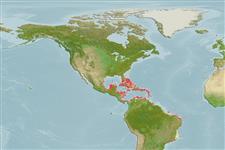Classification / Names
Common names | Synonyms | Catalog of Fishes (gen., sp.) | ITIS | CoL | WoRMS | Cloffa
Actinopterygii (ray-finned fishes) >
Perciformes (Perch-likes) >
Chaenopsidae (Pike-, tube- and flagblennies)
Etymology: Emblemariopsis: Latin, emblema = insertion, inlaid work, raised ornament + Greek, opsis = appearance (Ref. 45335).
Environment / Climate / Range
Ecology
Marine; reef-associated; depth range 2 - 8 m (Ref. 40101). Tropical, preferred ?
Western Atlantic: Bahamas to Santa Catarina, Brazil (Ref. 57756).
Size / Weight / Age
Maturity: Lm ? range ? - ? cm
Max length : 3.3 cm SL male/unsexed; (Ref. 51458)
Dorsal
soft rays
(total): 10-13;
Anal
spines: 2. Species distinguished by: underside of head dark or pale, with a series of distinct, small dark spots extending posteriorly along ventral edge of opercle; first dorsal-fin spine 2 to 3 times length of third spine, distal margin appearing angular as it drops abruptly to the shorter third spine; segmented dorsal-fin rays 10 to 13; total dorsal-fin elements 30 to 38; pectoral-fin rays 13; supraorbital cirrus on each eye, shorter than eye diameter and arising from a single base; head smooth anteriorly, never spiny; tip of lower jaw not projecting beyond tip of upper jaw and without fleshy projection; one row of teeth on each palatine bone; no stripe or series of dark blotches on head and body; edge of opercle with series of small, round dark spots, or uniformly pigmented. Common amongst Chaenopsids: small elongate fishes; largest species about 12 cm SL, most under 5 cm SL. Head usually with cirri or fleshy flaps on anterior nostrils, eyes, and sometimes laterally on nape; gill membranes continuous with each other across posteroventral surface of head. Each jaw with canine-like or incisor-like teeth anteriorly; teeth usually also present on vomer and often on palatines (roof of mouth). Dorsal-fin spines flexible, usually outnumbering the segmented soft rays, spinous and segmented-rayed portions forming a single, continuous fin; 2 flexible spines in anal fin; pelvic fins inserted anterior to position of pectoral fins, with 1 spine not visible externally and only 2 or 3 segmented (soft) rays; all fin rays, including caudal-fin rays, unbranched (simple). Lateral line absent. Scales absent (Ref.52855).
Inhabits muddy bottoms (Ref. 26340); minimum depth range documented from Santa Catarina, South Brazil (S.Floeter, pers.comm. 04/10).
Life cycle and mating behavior
Maturity | Reproduction | Spawning | Eggs | Fecundity | Larvae
Claro, R., 1994. Características generales de la ictiofauna. p. 55-70. In R. Claro (ed.) Ecología de los peces marinos de Cuba. Instituto de Oceanología Academia de Ciencias de Cuba and Centro de Investigaciones de Quintana Roo. (Ref. 26340)
IUCN Red List Status (Ref. 115185)
CITES (Ref. 94142)
Not Evaluated
Threat to humans
Harmless
Human uses
More information
ReferencesAquacultureAquaculture profileStrainsGeneticsAllele frequenciesHeritabilityDiseasesProcessingMass conversion
Tools
Special reports
Download XML
Internet sources
Estimates of some properties based on models
Phylogenetic diversity index (Ref.
82805): PD
50 = 0.5001 [Uniqueness, from 0.5 = low to 2.0 = high].
Bayesian length-weight: a=0.00457 (0.00182 - 0.01148), b=3.08 (2.86 - 3.30), in cm Total Length, based on LWR estimates for this (Sub)family-body shape (Ref.
93245).
Trophic Level (Ref.
69278): 3.3 ±0.5 se; Based on size and trophs of closest relatives
Resilience (Ref.
69278): Low, minimum population doubling time 4.5 - 14 years (Fec assumed to be < 100).
Vulnerability (Ref.
59153): Low vulnerability (10 of 100) .
